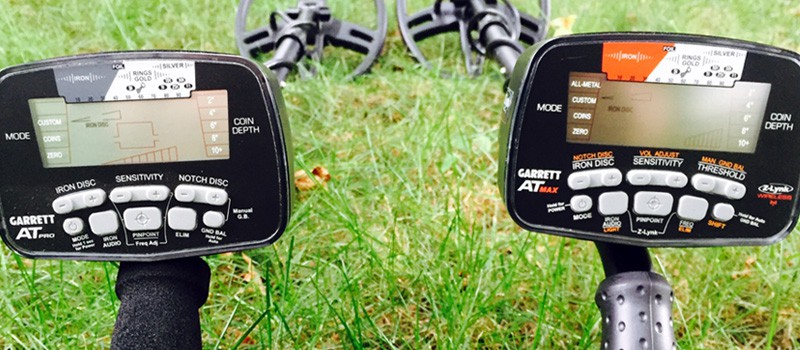Garrett Metal Detectors has been a brand leader – perhaps the brand leader – in metal detecting for years, due in large part to the success of their AT family of detectors. This article focuses on two of these detectors and their respective features: the AT Pro and AT Max.
Which is better Garrett AT Pro or AT Max?
The difference between Garrett AT Pro and AT Max is that the AT Max has more features such as True All-Metal mode, threshold, Z-Lynk wireless headphones, and a backlit display. It’s also a newer model with a slightly higher price tag.
Both the AT Pro and AT Max are solid, reliable, advanced detectors from a reputable company – so which one should you choose? As the newer detector, the AT Max clearly wins out on features, but not every buyer will deem these necessary, such as a backlit display or an integrated Z-Lynk wireless system. The AT Pro provides most of the functionality of the AT Max and may be more attractive to beginners due to the availability of its more novice-friendly standard modes. Importantly, the AT Pro is also somewhat cheaper.
If you’re an experienced detectorist, especially one who has previous experience with Garrett metal detectors, the AT Max is probably your best bet. It’s loaded with features to make your detecting excursions as hassle-free as possible and it really can just about do it all, including hunting in saltwater. If you’re dipping your toes in the proverbial waters of metal detecting, the AT Pro may be a better choice for you. It’s versatile, tried and tested, and is available at a lower price point than the AT Max. If you plan to do a significant amount of beach detecting other than dry sand however, you may need to weigh your options more carefully.
AT Pro
Since its debut in 2010, the AT Pro has been become one of the standard machines used by detectorists around the world. The AT Pro features a numerical VDI, iron audio (to choose whether or not to hear iron otherwise discriminated out), a waterproof coil and control box, automatic and manual ground balancing to adjust for soil conditions, built-in pinpointing, and six different operating modes. It also comes equipped with an 8.5” x 11” DD coil. This can be swapped out with different coils from Garrett or other manufacturers that make products for the AT series, such as NEL.
The operational modes of the AT Pro are worth looking at in some detail. Three of these modes (“Custom”, “Coins”, and “Zero”) are labeled “standard” and provide audio similar to that of the detectors in Garrett’s line of Ace detectors. Audio response (the “beep”) is the same no matter how big or how deep your target is. This mode is typically preferred by those who are new to detecting or this machine, but old hands tend to prefer the Pro modes. The Pro modes are the same as the standard modes (“Custom”, “Coins”, and “Zero”), but they feature proportional audio, meaning that the audio can give the user far more information about a target’s size, depth, and geometry. More information of course also means a steeper learning curve and more hours invested to learn the ropes.
With its wide range of the features and versatility, it is generally agreed that the AT Pro is one of the most capable “turn on and go” detectors. In short, it is user-friendly and even an inexperienced detectorist can be digging targets within minutes. It is a solid all-around machine for relic hunting, detecting for coins, or searching for jewelry.
Read my complete Garrett AT Pro review.
AT Max
The AT Max, released in 2017, has been seen as a step forward from the AT Pro as well as Garrett’s answer to years of feedback from users of the AT Pro. Many of the features are identical, such as iron audio, submergibility, and proportional audio, plus a similar ground balance system. But the AT Max has some standout selling points in comparison to the Pro.
Z-Lynk wireless headphones
Any detectorist with more than a few hours under his or her belt has gotten their headphone cable tangled, knotted, or even come close to cutting through it while digging a plug. The Z-Lynk system eliminates these problems by wirelessly transmitting the audio of the AT Max to your MS-3 headphones. The Z-Lynk-enabled pinpointer can also be used with this system. While you can purchase an aftermarket Z-Lynk system that will work with most detectors, including the AT Pro, it is not cheap. The AT Max integrates this wireless system from the factory.
True All-Metal mode
The ability to discriminate out certain types of metal when detecting can come with a price. Signals that without discrimination might seem to be worth digging can seem otherwise with discrimination dialed up. On top of that, some believe that all-metal mode can provide greater depth compared to modes that incorporate discrimination, though this was more true of previous generations of metal detectors than today. This mode was included in the AT Max at least partially due to feedback from AT Pro users who prefer a mode specifically intended for detecting without discrimination. A lot of folks confuse True All-Metal with zero discrimination mode. They are not the same thing. Zero discrimination is what most metal detectors use. It still has some level of filtering which reduces maximum depth. True All Metal is threshold-based and maximizes depth capabilities.
Backlight display
If you’ve been detecting for a while but haven’t tried detecting at night, you’re missing out. All you need to start is your regular detecting equipment, a headlamp, and a permission where you’re free to be out at night. A digital display with a backlight isn’t strictly necessary for night hunting, but it certainly makes it a lot easier. This is undoubtedly a nice feature for anyone who detects at night or would like to start.
Saltwater optimization
The AT Pro performs admirably in almost any hunting scenario – mineralized soils, dry sand, freshwater, and more. But one of the major weaknesses of the AT Pro is its poor performance in saltwater and sand wet with saltwater. Even with frequent ground balancing, depth is massively reduced and you’re generally better off sticking to soil and dry sand. But Garrett has attempted to address this shortcoming of the AT Pro in the Max. With the right settings, the AT Max is a very respectable beach hunting machine with reasonable depth in water and wet sand, all with minimal chatter.
Read my complete Garrett AT Max review.
Final thoughts
Whether you end up with an AT Pro or an AT Max, you will be getting a quality mid-range metal detector. Both are capable of meeting the needs of most detectorists, especially those primarily hunting on land rather than in water. When it comes down to it, the potential buyer will have to consider what features they really need and how much they are willing to shell out for the extras.

